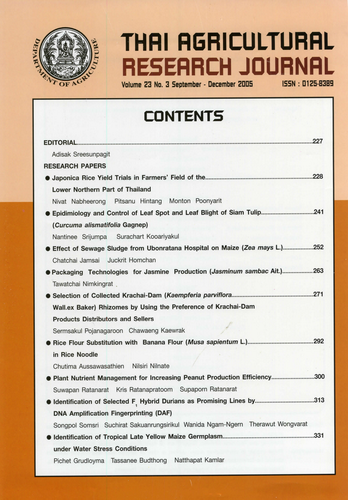Epidimiology and Control of Leaf Spot and Leaf Blight of Siam Tulip (Curcuma alismatifolia Gagnep)
DOI:
https://doi.org/10.14456/thaidoa-agres.2005.20Keywords:
Siam tulip, Curcuma alismatifolia, leaf spot, leaf blight, Phoma sp., Acremonium sp.Abstract
The study of epidemiology and control of leaf spot and leaf blight of Siam tulip (Curcuma alismatifolia Gagnep) was conducted at Chiangrai Horticultural Research Centre in 2002-2003. Siam tulip were planted in 15 x 30 cm plastic bags. Planting media was comprised of soil: sand: ashes at the ratio of 2:1:1. Randomized complete block design with 4 replication was assigned to study the effects of flusilazole 40% W/V, diphenoconazole 250 EC, mancozeb 80% WP and carbendazim 50% W/V. Sixty bags of siam tulip plants were placed on a bamboo rack making as a 1.10 x 2.40 m. experimental plot. Chemicals were applied once a week and number of infected plants were examined everyday. It was found that Acremonium sp.and Phoma sp. Were major fungi that caused leaf spot and leaf blight symptoms on curcuma plants. The epidemiology was related to the amount of rainfall and the stage of plant growth. In control plots, 98% of plats were infected with Acremonium sp. and Phoma sp. Diphenoconazole 250 EC showed the best control for leaf blight whereas flusulazole 40% W/V, carbendazim 50% W/V and mancozeb 80% WP had controlled leaf blight at 90, 75, 50 and 39% respectively. Flusilazole and diphenoconazole were able to control leaf spot 95 and 85%, whereas mancozeb and carbendazim were able to control leaf spot only 16 and 4% respectively.
Downloads
Published
How to Cite
Issue
Section
License

This work is licensed under a Creative Commons Attribution-NonCommercial-NoDerivatives 4.0 International License.
Thai Agricultural Research Journal



